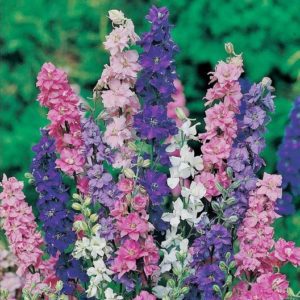In true Halloween spirit, we racked our minds for the spookiest gardening topics. Sure, carnivorous plants are plenty spooky, but that subject appears on every gardening blog towards the end of October. Then it clicked, one thing that happens to every flower, unfortunately, is that they will eventually die. In order to keep your flowers producing colorful blooms, every gardener needs to channel their dark side, grab their sharpest sheers, and CHOP off the head of spent blooms.
OK, maybe it’s not quite as ominous as we hoped it would be, but understanding how and when to deadhead flowers around your home garden can not only extend the blooming period of each plant, but will also encourage new growth, which means even more flowers! Keep reading to learn how to identify which flowers should be deadheaded, how to deadhead different types of flowers, and when to put the shears away and leave your flowers alone for a few months.
Commonly Asked Questions about Deadheading Flowers
Why Deadhead Your Flowers?
Deadheading is one of the most important maintenance items that a home gardener must do during the growing season. As a flower begins to fade, not only do they lose their visual appeal to the human eye, but they also lose their utility in the garden for attracting pollinators. If a flower is left to completely fade, drop its leaves, and “die”, the plant takes this as a cue to divert energy into developing a seed head. During the end of the growing season, this is actually a desirable result, but while in the swing of things during the growing season, staying on top of deadheading will keep each plant’s energy focused on developing new growth. In addition to encouraging new growth from flowers and plants, deadheading dying blooms will help to prevent disease from possibly spreading, as well as discouraging non-beneficial insects from taking up residence in and around the dead flowers.

How Do I Deadhead My Flowers?
Depending on the type of flower or plant, the deadheading process can be quite simple, or a bit more time consuming. For flowers that have a single bloom at the end of each stem, like zinnias or daisies, simply cut off the spent bloom, and stem below it, down to the first set of leaves. The length of stem you’ll have to cut will vary based on the type of flower, but don’t worry, you’re not hurting your plant by doing this! Since most single flowered stems are quite thin, you could even just pinch and snap the stem at the first set of leaves, although using a pair of clean shears is best.
For more spiked flower species, like lupine or delphinium, it’s important to keep an eye on the flowers on each stem. Since each stem is filled with small flowers, it’s possible that the flowers on the upper portion of the stem are still in full bloom, while the lower flowers are beginning to fade. Once you see the lower flowers losing their luster, it’s time to deadhead to ensure that these lower flowers don’t go to seed. To deadhead these spiky flowers, you’re again going to cut down the stem, right above the first set of leaves.

With clusters of flowers all growing together, like what is found with roses or daylilies, there are two approaches you can take to deadheading the growth. First option is to individually deadhead spent blossoms as they begin to die. This channels the plant’s energy back into new growth, and often results to double blooms growing back into the spot you deadheaded. The second option is more appropriate for when there are multiple flowers on one stem that are dying, during which you cut the stem all the way back to the base of the plant. This is also commonly referred to as a “hard prune.”
What Kinds of Flowers Should I Deadhead?
Great question! Most annual plants and flowers, as well as many perennials, will benefit greatly from regular deadheading during the growing season. While the number of flower species that benefit from a beheading every once in a while, is massive, here’s a short list of some common flowers and plants found in home gardens that should be deadheaded regularly:
- Baby’s breath
- Dahlias
- Daylilies
- Delphinium
- Echinacea
- Geraniums
- Lavenders
- Lilacs
- Lupine
- Painted daisies
- Petunias
- Roses
- Rudbeckia
- Zinnias
How Do I Know When to Stop Deadheading My Flowers?
For any of the previously mentioned types of flowers, you can continue to deadhead them throughout the entire growing season. As temperatures begin to drop and your home garden begins to head into dormancy, you can stop deadheading and allow the flower to go to seed. In many instances, allowing the flower to go to seed provides some delicious snacks to birds that may visit your garden during their fall migration. For flowers that you’d like to grow back next season, you can either collect the seeds as the flower blooms dry out, or simply allow the flower to self-sow.